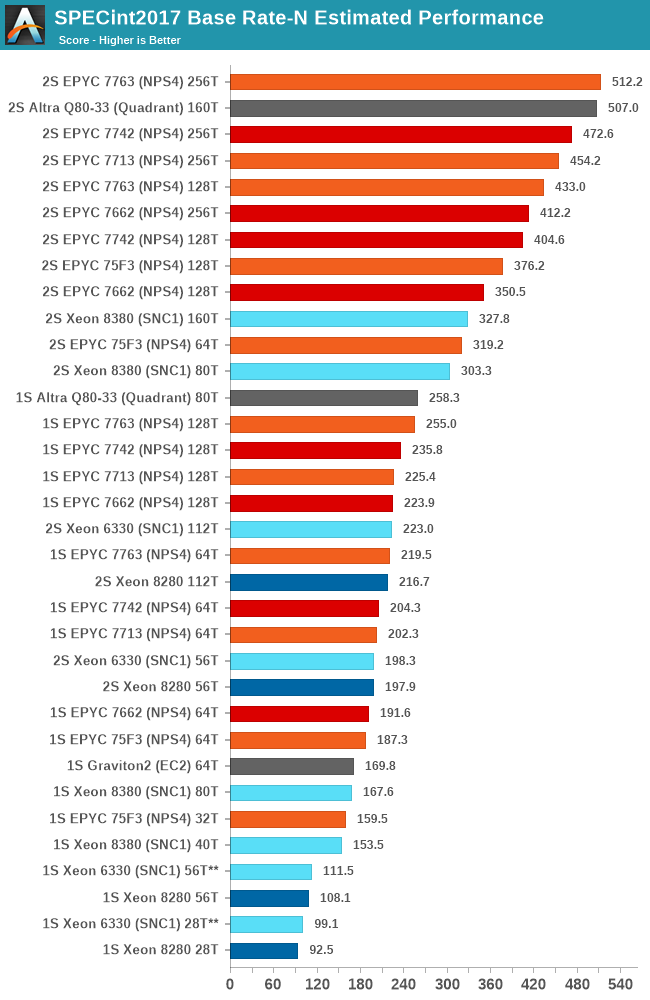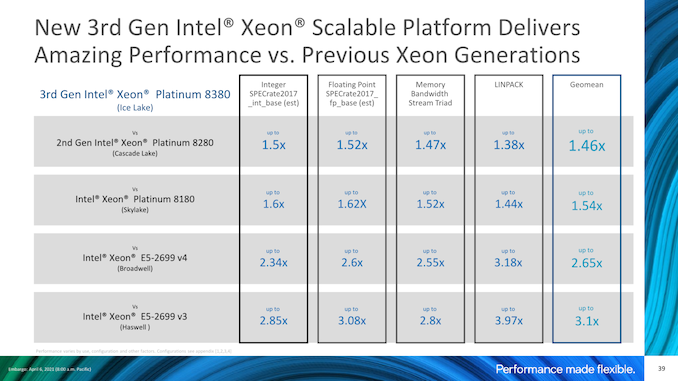Intel 3rd Gen Xeon Scalable (Ice Lake SP) Review: Generationally Big, Competitively Small
by Andrei Frumusanu on April 6, 2021 11:00 AM EST- Posted in
- Servers
- CPUs
- Intel
- Xeon
- Enterprise
- Xeon Scalable
- Ice Lake-SP
SPEC - Multi-Threaded Performance
Picking up from the power efficiency discussion, let’s dive directly into the multi-threaded SPEC results. As usual, because these are not officially submitted scores to SPEC, we’re labelling the results as “estimates” as per the SPEC rules and license.
We compile the binaries with GCC 10.2 on their respective platforms, with simple -Ofast optimisation flags and relevant architecture and machine tuning flags (-march/-mtune=Neoverse-n1 ; -march/-mtune=skylake-avx512 ; -march/-mtune=znver2 (for Zen3 as well due to GCC 10.2 not having znver3).
The new Ice Lake SP parts are using the -march/-mtune=icelake-server target. It’s to be noted that I briefly tested the system with the Skylake binaries, with little differences within margin of error.
I’m limiting the detailed comparison data to the flagship SKUs, to indicate peak performance of each platform. For that reason it’s not exactly as much an architectural comparison as it’s more of a top SKU comparison.

To not large surprise, the Xeon 8380 is posting very impressive performance advancements compared to the Xeon 8280, with large increases across the board for all workloads. The geo-mean increase is +54% with a low of +40% up to a high of +71%.
It’s to be noted that while the new Ice Lake system is a major generational boost, it’s nowhere near enough to catch up with the performance of the AMD Milan or Rome, or Ampere’s Altra when it comes to total throughput.

Looking at the FP suite, we have more workloads that are purely memory performance bound, and the Ice Lake Xeon 8380 again is posting significant performance increases compared to its predecessor, with a geo-mean of +53% with a range of +41% to +64%.
In some of the workloads, the new Xeon now catches up and is on par with AMD’s EPYC 7763 due to the fact that both systems have the same memory configuration with 8-channel DDR4-3200.
In any other workloads that requires more CPU compute power, the Xeon doesn’t hold up nearly as well, falling behind the competition by significant margins.

In the aggregate geomean scores, we’re seeing again that the new Xeon 8380 allows Intel to significantly reposition itself in the performance charts. Unfortunately, this is only enough to match the lower core count SKUs from the competition, as AMD and Ampere are still well ahead by massive leads – although admittedly the gap isn’t as embarrassing as it was before.

In the floating-point suite, the results are a bit more in favour for the Xeon 8380 compared to the integer suite, as the memory performance is weighed more into the total contribution of the total performance. It’s still not enough to beat the AMD and Ampere parts, but it’s much more competitive than it was before.
The Xeon 6330 is showcasing minor performance improvements over the 8280 and its cheaper equivalent the 6258R, but at least comes at half the cost – so while performance isn’t very impressive, the performance / $ might be more competitive.
Our performance results match Intel’s own marketing materials when it comes to the generational gains, actually even surpassing Intel’s figures by a few percent.
If you would be looking at Intel’s slide above, you could be extremely enthusiastic about Intel’s new generation, as indeed the performance improvements are extremely large compared to a Cascade Lake system.
As impressive as those generational numbers are, they really only help to somewhat narrow the Grand Canyon sized competitive performance gap we’ve had to date, and the 40-core Xeon 8380 still loses out to a 32-core Milan, and from a performance / price comparison, even a premium 75F3 costs 40% less than the Xeon 8380. Lower SKUs in the Ice Lake line-up would probably fare better in perf/$, however would also just lower the performance to an even worse competitive positioning.











169 Comments
View All Comments
Shorty_ - Thursday, April 8, 2021 - link
did you read the article before commenting?I'm inclined to believe him-- I think yields are still an issue (which is why they have so many dark cores) and that getting enough chips to meet demand on the 40 core parts will be tough.
Hifihedgehog - Saturday, April 17, 2021 - link
LOL Gondalf. Who pays $1000 for your thoughts?DannyH246 - Tuesday, April 6, 2021 - link
Another Intel marketing presentation from www.IntelTech.comLet me summarize - slower, hotter, pricier than the AMD equivalent. Zero reason to buy.
SarahKerrigan - Tuesday, April 6, 2021 - link
"As impressive as the new Xeon 8380 is from a generational and technical stand-point, what really matters at the end of the day is how it fares up to the competition. I’ll be blunt here; nobody really expected the new ICL-SP parts to beat AMD or the new Arm competition – and it didn’t."How is that "Intel marketing"?
ParalLOL - Tuesday, April 6, 2021 - link
In this case you did not even need to read the article to know what the tone would be. I guess Danny did not manage to read the title either.fallaha56 - Tuesday, April 6, 2021 - link
how? the chip isn't worth touching with bargepolethat's if the 38-40 core parts are actually available
which they won't be
and what sysadmin is going to go demand this when Milan is a drop in replacement and Intel next-gen is an entirely new platform
Azix - Tuesday, April 6, 2021 - link
Are you assuming they won't be because semiaccurate said so? They have 100% track record? Didn't he also say Rocket Lake S wouldn't clock high at all?yeeeeman - Tuesday, April 6, 2021 - link
this ain't intel marketing presentation. This is a laid back, relaxed, non-biased and professional review. Not everyone hates Intel with their whole heart and not every reviewer hunts for clicks, so as to say that the new Intel server chip are shit. In the grand scheme of things, sure, they are not competitive, BUT Intel still has a few advantages over AMD that for some customers it might matter more than absolute performance.In the server space, price, dependability, upgradeability, quality and support is the name of the game. AMD, as we know even from consumer products isn't that amazing when it comes to drivers, BIOS quality and fixing bugs, whereas Intel is much more reliable in this regard. Sure, sure, you might say I am a fanboy, but first check what I say and then call me that if you want. Nevertheless, Intel needs Sapphire Rapids badly because even with all their advantages, they will keep losing marketshare.
fallaha56 - Tuesday, April 6, 2021 - link
absolute nonsense from a fanboi yesIntel is currently slower, buggier and overpriced with horrific security issues meaning you can have: slow and insecure or even slower and barely secure
and who ever thought servers would regularly need watercooling
also what on Earth are you talking about upgrades? this entire platform is getting chucked shortly while AMD has offered multiple generations on the same platform for years with an upgrade bringing DDR5 and PCIe 5
fallaha56 - Tuesday, April 6, 2021 - link
wonderfully summed up here:https://semiaccurate.com/2021/04/06/intels-ice-lak...